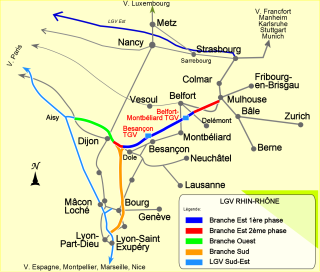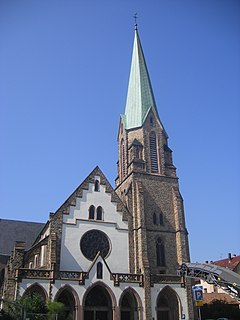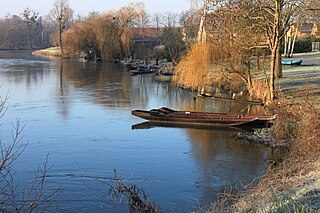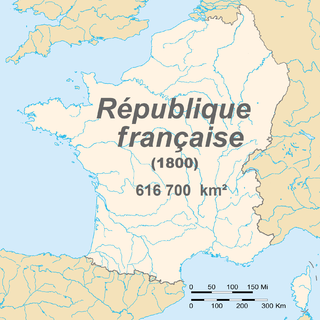
Alsace is a cultural and historical region in eastern France, on the west bank of the upper Rhine next to Germany and Switzerland.

Bas-Rhin is a department in Alsace which is a part of the Grand Est super-region of France. The name means "Lower Rhine", however, geographically speaking it belongs to the Upper Rhine region. It is, with the Haut Rhin, one of the two departments of the traditional Alsace region. The more populous and densely populated of the pair, it had 1,125,559 inhabitants in 2017. The prefecture and the General Council are based in Strasbourg. The INSEE and Post Code is 67.

Haut-Rhin is a department in the Grand Est region of France, named after the river Rhine. Its name means Upper Rhine. Haut-Rhin is the smaller and less populated of the two departments of the former administrative Alsace region, the other being the Bas Rhin. Especially after the 1871 cession of the southern territory known since 1922 as Territoire de Belfort, although it is still densely populated compared to the rest of metropolitan France.

The LGV Rhin-Rhône is a high-speed railway line, the first in France to be presented as an inter-regional route rather than a link from the provinces to Paris, though it actually is used by some trains to/from Paris. The first phase of the eastern branch opened on 11 December 2011. Construction of its second phase was expected to start in 2014 but has unclear funding at this stage.

Bischwiller is a commune in the Bas-Rhin department in Grand Est in northeastern France just west of the Moder River.

Braubach is a municipality in the Rhein-Lahn-Kreis, in Rhineland-Palatinate, Germany. It is situated on the right bank of the Rhine, approx. 10 km southeast of Koblenz. Braubach has assorted medieval architecture intact, including portions of the town wall, half-timbered buildings, and castle Marksburg on the hill above.

Bischheim is a commune in the Bas-Rhin department and Grand Est region of north-eastern France.

The Canal de la Marne au Rhin is a canal in north-eastern France. It connects the river Marne and the Canal entre Champagne et Bourgogne in Vitry-le-François with the port of Strasbourg on the Rhine. The original objective of the canal was to connect Paris and the north of France with Alsace and Lorraine, the Rhine, and Germany. The 313 km (194 mi) long canal was the longest in France when it opened in 1853.

La Wantzenau is a commune in the Bas-Rhin department in Grand Est in north-eastern France.

Seltz is a commune in the Bas-Rhin department of the Grand Est region in north-eastern France. It is located on the Sauer river near its confluence with the Rhine, opposite the German town of Rastatt.

Eckwersheim is a commune, in the Bas-Rhin department in Grand Est in north-eastern France. It is around 11 km (7 mi) north of Strasbourg.

Griesheim-près-Molsheim is a commune in the Bas-Rhin department in Grand Est in north-eastern France.

Gunstett is a commune in the Bas-Rhin department in Grand Est in north-eastern France.

Hilsenheim is a commune in the Bas-Rhin department in Alsace in north-eastern France.

Rhinau is a commune in the Bas-Rhin department of Grand Est in north-eastern France.

Fessenheim is a commune in the Haut-Rhin department in Grand Est in north-eastern France.

The Army of the Rhine was formed in December 1791, for the purpose of bringing the French Revolution to the German states along the Rhine River. During its first year in action (1792), under command of Adam Philippe Custine, the Army of the Rhine participated in several victories, including Mainz, Frankfurt and Speyer. Subsequently, the army underwent several reorganizations and merged with the Army of the Moselle to form the Army of the Rhine and Moselle on 20 April 1795.

Die Rheinnixen is a romantic opera in four acts by Jacques Offenbach. The original libretto by Charles-Louis-Etienne Nuitter was translated into German by Alfred von Wolzogen.

The Left Bank of the Rhine was the region north of Lauterbourg, in present-day western Germany, that was conquered during the War of the First Coalition and annexed by France. Because the attempt to create a Cisrhenian Republic foundered, the territories west of the Rhine were reorganized into several départements among the French first republic. After the allied victory over Napoleon in 1814 these territories were provisionally administered by the Central Administrative Departement (Zentralverwaltungsdepartement). The Sarre province and the district of Landau in der Pfalz previously French before the Napoleonic wars were under the definitive act of the congress of Vienna ceded to the members of the coalition. The recent annexations done under the first republic were restituted. From these territories the Bavarian Circle of the Rhine (Rheinkreis) and the Hessian province of Rhenish Hesse (Rheinhessen) were formed in 1816. The regions to the north went to Prussia and were initially part of the two provinces of Jülich-Cleves-Berg and the Grand Duchy of the Lower Rhine, from which the Rhine Province emerged in 1822. The southern left Rhine territories, which had for centuries been under imperial rule in the Holy Roman Empire had been seized by France, mostly in the 17th century, were annexed to the new German empire in 1871, following France's defeat in the Franco-Prussian War. The region was consolidated as the Imperial territory of Alsace-Lorraine for a period of 48 years (1871-1919), before being restituted to France in the wake of the First World War.

The natural borders of France are a political and geographic theory developed in France, notably during the French Revolution. They correspond to the Rhine, the Atlantic Ocean and Mediterranean Sea, the Pyrenees and the Alps, according to the revolutionaries.
This page is based on this
Wikipedia article Text is available under the
CC BY-SA 4.0 license; additional terms may apply.
Images, videos and audio are available under their respective licenses.



















